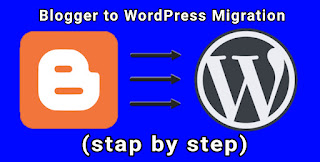Mastering the Blogger to WordPress Migration: A Comprehensive Guide for a Seamless Transition
Transferring your Blogger blog to WordPress is a significant undertaking, but with meticulous planning, you can achieve this without compromising your hard-earned ranking and traffic. In this comprehensive 1500-word guide, we'll walk through each step of the process, ensuring a smooth transition to Wordpress.
understanding the Importance of a Thoughtful Migration
When migrating from Blogger to WordPress, it's crucial to recognize that the process involves not just transferring content but preserving your SEO ranking and maintaining the flow of traffic. A thoughtful approach is necessary to seamlessly navigate this transition.
Step 1: Preparation for a Smooth Migration
1.1 Save URLs and Backup Content
Before initiating the transfer, safeguard your post URLs by copying them into a Notepad document. Additionally, take a comprehensive backup of your Blogger blog content to prevent any potential data loss during the migration.
Step 2: Custom Domain Settings
2.1 Disconnect from Blogger
In your Blogger dashboard, navigate to Settings and remove the custom domain associated with your blog. Subsequently, connect your custom domain with the web hosting service you've chosen for your WordPress site.
Step 3: Switching from Blogger to WordPress
3.1 Import Content
Access your WordPress dashboard, go to Tools, and select Import. Install the Blogger importer and run the tool. Choose the backup file and begin the import process, making sure to assign the imported content to a relevant user.
Step 4: Permalink (URL) Settings for SEO Optimization
4.1 Optimize for SEO
Head to WordPress Settings and select Permalinks. Opt for the "Month and name" option to maintain a consistent URL structure. Save changes to ensure SEO-friendly URLs.
Step 5: Important Settings and Redirection
5.1 Maintain SEO
Set your time zone in WordPress General Settings. Install the "Blogger to WordPress Redirection" plugin, configure it, obtain the code, and integrate it into your Blogger template to manage URL redirection.
Step 6: Plugin Installation for .html Removal
6.1 Enhance URLs
Install the "Remove .html from URL" plugin in WordPress. Adjust the permalink structure by eliminating the trailing slash and save changes for cleaner, more user-friendly URLs.
Step 7: Update Internal Links
7.1 Ensure Accuracy
Manually review and update internal links within your blog posts as needed. Cross-verify the functionality of all links post-migration to ensure a seamless user experience.
Step 8: Check and Optimize Theme
8.1 Enhance Appearance
Explore and activate a WordPress theme that aligns with your blog's aesthetic. Customize the theme to match your preferences, providing a visually appealing and cohesive look to your new WordPress site.
Step 9: Verify Migration
9.1 Confirm Successful Transfer
Visit your WordPress site and meticulously check various posts and pages to ensure content integrity. Verify that the new URLs are in place, and the overall appearance aligns with your expectations.
Step 10: Update Sitemap and Search Console
10.1 Inform Search Engines
Submit the new sitemap to Google Search Console, and notify search engines about the migration. This step is crucial for maintaining visibility and ensuring that your WordPress site gets indexed appropriately.






0 Comments